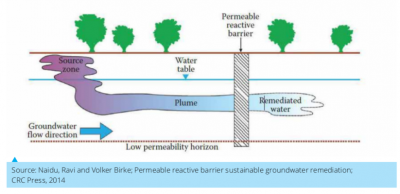
Groundwater is heavily withdrawn for irrigation, industrial and municipal purpose thorough out the world. Researchers have found that it is getting polluted due to cctive barrier (PRB) can be effective in cleaning the polluted aquifers. A PRB is an in situ permeable treatment zone designed to intercept and remediate a groundwater contaminant plume. For the proper design of the PRB and its performance assessment, groundwater flow and solute transport modeling is very important. Waontamination coming from industrial discharges, septic tanks, other anthropogenic sources and from return irrigation flows. To remediate the groundwater permeable reall type and the funnel type PRBs can be suitably placed to arrest the contamination and allow treated water to arrive at the desired take off point. Efforts were made in this regards to simulate PRB for a synthetic aquifer where the pollution source was cut. After getting the plume direction in the contaminated aquifer, first a continuous PRB is used in the aquifer region for the decontamination and subsequently a funnel and gate type PRB is also considered in the same aquifer to compare its efficiency with the former one. The effective cost comparison of the two PRBs is also made without compromising on the acceptable quality of groundwater. The successful simulation of the PRBs in our study suggests its potential for other similar real field aquifer problems, where before installation of PRB many desired output viz. degree of contaminant reduction, time of reduction and economic consideration can be analysed with simulation studies.
Prof. A K Rastogi
